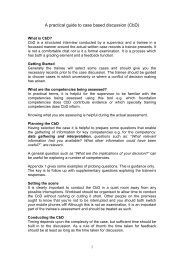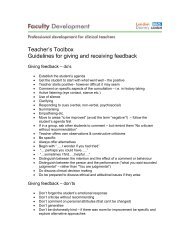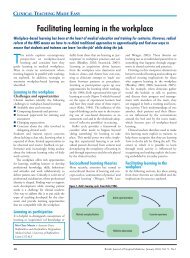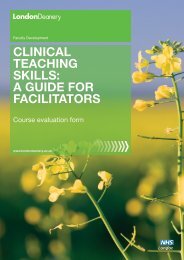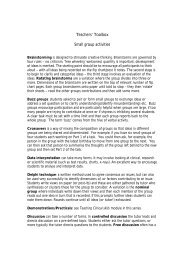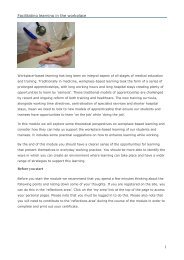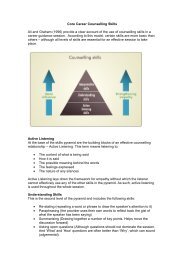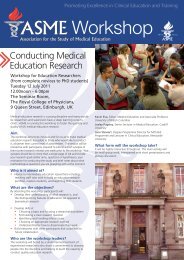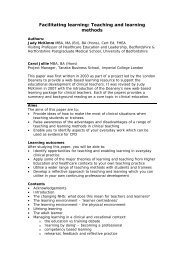Curriculum development module - Faculty Development - London ...
Curriculum development module - Faculty Development - London ...
Curriculum development module - Faculty Development - London ...
You also want an ePaper? Increase the reach of your titles
YUMPU automatically turns print PDFs into web optimized ePapers that Google loves.
oundaries. Teaching units from subject disciplines are fused together around a<br />
meaningful organising themes/concept such as body systems or community<br />
medicine. In medical education the term vertical integration describes the<br />
blurring of boundaries between pre-clinical and clinical courses whereas<br />
horizontal integration describes how knowledge and skills from many<br />
disciplines are clustered around themes such as body systems (eg. a<br />
cardiovascular systems course might include the anatomy, physiology,<br />
biochemistry, pathology, clinical medicine, sociology, epidemiology, etc. relating<br />
to the cardiovascular system).<br />
The integrated approach:<br />
Positive aspects:<br />
• Demonstrates interrelationship between disciplines and encourages<br />
holistic view of patients’ problems<br />
• Harden (1984) suggests that integrated courses enable students to<br />
learn meaningful sets of information which are more easily retained<br />
and applied to other situations. They can encourage the<br />
<strong>development</strong> of higher-level objectives eg. application of<br />
knowledge, analytical skills and problem solving<br />
• Team teaching and collaboration between subject staff is promoted.<br />
• Integrated courses may also enable sharing of resources between<br />
departments and teachers<br />
Limitations:<br />
• Some subjects/topics may be omitted or over taught and close<br />
supervision and central management of the curriculum is needed to<br />
avoid this<br />
• Organisational boundaries such as departments and funding<br />
mechanisms may create barriers to integration<br />
One of the most influential approaches to medical education has been problem<br />
based learning (PBL) as developed by Barrows, Harden and others. PBL aims to<br />
stimulate students to observe, think, define, study, analyse, synthesise and<br />
evaluate a problem. The ‘problems’ or cases are written to simulate real life<br />
clinical problems which are multidimensional and which encourage students to<br />
think as they would in real life clinical situations. Medical schools that have used a<br />
PBL approach include McMaster (Canada) and Newcastle (Australia) and some UK<br />
schools have also introduced a PBL course.<br />
Have a look at the PBL section in the Learning resources paper for more<br />
information about PBL and how to put it into practice.<br />
Advantages of a PBL curriculum:<br />
• Helps a student to develop skills in solving health related problems<br />
• Promotes self directed learning and spirit of enquiry<br />
• Provokes a sense of critical thinking and reasoning<br />
• Retention and application of knowledge is reinforced in a similar<br />
way to that in the clinical context<br />
• Develops integrated body of knowledge based on real and common



